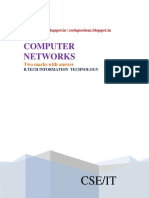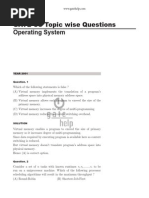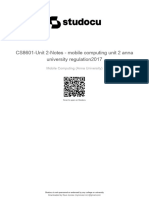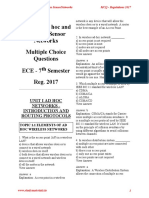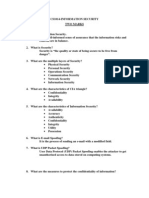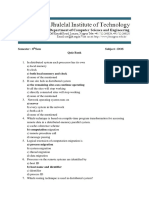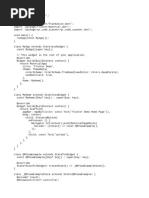0 ratings0% found this document useful (0 votes)
3K viewsDistributed Computing Question Paper
This document contains an 18 question multiple choice test on the topic of distributed computing. The test covers topics such as challenges in distributed systems, agreement protocols, deadlock detection algorithms, distributed mutual exclusion algorithms like Lamport's algorithm, types of distributed operating systems, characteristics of distributed systems, and properties of peer-to-peer architectures. The test has two sections, with the first being 18 objective questions worth 1 mark each, and the second being 4 subjective questions worth 3 marks each where students must attempt any 3 questions.
Uploaded by
atul211988Copyright
© © All Rights Reserved
We take content rights seriously. If you suspect this is your content, claim it here.
Available Formats
Download as DOCX, PDF, TXT or read online on Scribd
0 ratings0% found this document useful (0 votes)
3K viewsDistributed Computing Question Paper
This document contains an 18 question multiple choice test on the topic of distributed computing. The test covers topics such as challenges in distributed systems, agreement protocols, deadlock detection algorithms, distributed mutual exclusion algorithms like Lamport's algorithm, types of distributed operating systems, characteristics of distributed systems, and properties of peer-to-peer architectures. The test has two sections, with the first being 18 objective questions worth 1 mark each, and the second being 4 subjective questions worth 3 marks each where students must attempt any 3 questions.
Uploaded by
atul211988Copyright
© © All Rights Reserved
We take content rights seriously. If you suspect this is your content, claim it here.
Available Formats
Download as DOCX, PDF, TXT or read online on Scribd
You are on page 1/ 2
Tula’s Institute
Dhoolkot, Dehradun 5. An RPC (remote procedure call) is initiated by the:
(a) server
2nd Sessional Test (b) client
(c) both (a) and (b)
Course: B.Tech SEMESTER- VIII (d) neither (a) nor (b)
Branch: Computer Science & Engineering 6. What is not true about distributed system ?
Subject with Code – TCS 801 DISTRIBUTED COMPUTING (a) It is a collection of processor
Session: 2019-20 Roll No. --------------------------------------- (b) All processors are synchronized
Date: 14th May 2020 Time :10 AM (c) They do not share memory
Answer sheet must be submit: atul.bhandari@tulas.edu.in & (d) None of the mentioned
cse.hod@tulas.edu.in (within 1 hour of 7. Which of the following is a Token based distributed mutual
exam start) exclusion algorithm?
(a) Lamport (b) Ricart-Agrawala
Time: 90 Mints. Max Marks: 30
(c)Maekawa (d)Suzuki-Kasami
Section A (Objective Type) (1 X 18= 18) 8. Algorithm that use Vector clocks are
Note: Attempt all question: (a)Birman-Schiper-Stephenson
(b)Schiper-Eggli-Sandoz
1. For proper synchronization in distributed systems ____________
(a) Prevention from the deadlock is must (c)All of the above
(b) Prevention from the starvation is must (d)None of the above
(c) Prevention from the deadlock & starvation is must 9. What things are transaction coordinator is responsible for ?
(d) None of the mentioned (a) Starting the execution of the transaction
2. In the token passing approach of distributed systems, processes are (b) Breaking transaction into a number of sub transactions
organized in a ring structure ____________ (c) Coordinating the termination of the transaction
(a) logically
(d) All of the mentioned
(b) physically
(c) both logically and physically 10. If timestamps of two events are same, then the events are
(d) none of the mentioned (a) concurrent
3. What is not true about distributed system ? (b) non-concurrent
(a) It is a collection of processor (c) monotonic
(b) All processors are synchronized (d) non-monotonic
(c) They do not share memory 11.To reach Byzantine agreement where m is no. of faulty processors,
(d) None of the mentioned
number of rounds necessary are
4. In distributed system mutual exclusion can be implemented through
(a) Semaphores (a) 2*m
(b) local kernel (b) m+1
(c) message passing (c) m-1
(d) None of the above. (d) None of the above
12. In the token passing approach of distributed systems, processes are d) none of the mentioned
organized in a ring structure logically
(a) logically (b) physically
(c) both logically and physically (d) none of the mentioned
13. What are types of distributed operating system ? Section B (Subjective Type) (4 X 3 = 12)
(a) Network Operating system
Note: Attempt any Three
(b) Zone based Operating system
(c) Level based Operating system Q.1 What is a Distributed System? Describe the various challenges and issues
(d) All of the mentioned in a distributed system.
Q.2 What are Agreement Protocols? Describe the classification of Agreement
14. Distributed systems should have?
Problems with examples..
(a) high security Q.3 Describe Ho and Ramamoorthy two phase centralized deadlock detection
(b) have better resource sharing algorithm.
(c) better system utilization Q.4 What are non-token based algorithms in distributed mutual exclusion
(d) low system overhead systems. Describe Lamport’s algorithm with example.
15. In a peer-to-peer architecture, peers can serve as
(a) Clients
(b) Servers
(c) Middle-system
(d) Both A and B
16. The transparency that enables accessing local and remote resources
using identical operations is called
(a) Concurrency transparency
(b) Access transparency
(c) Performance transparency
(d) Scaling transparency
17. Peer machines are built over
(a) 1 Server machine
(b) 1 Client machine
(c) Many Client machines
(d) Many Server machines
18. If one site fails in distributed system
(a) the remaining sites can continue operating
(b) all the sites will stop working
(c) directly connected sites will stop working
You might also like
- Logical Time: (Scalar Time, Vector Time, and Matrix Time)No ratings yetLogical Time: (Scalar Time, Vector Time, and Matrix Time)81 pages
- CS6551 Computer Networks Two Mark With Answer100% (7)CS6551 Computer Networks Two Mark With Answer35 pages
- Distibuted Database Management System NotesNo ratings yetDistibuted Database Management System Notes58 pages
- Winning Proposal Writing Training Workshop Report: September 2021No ratings yetWinning Proposal Writing Training Workshop Report: September 20216 pages
- AIT 524 L1 29 AUG: Everything in 1 Hour Video in Learning Resources0% (1)AIT 524 L1 29 AUG: Everything in 1 Hour Video in Learning Resources3 pages
- Third Year Sixth Semester CS6601 Distributed System 2 Mark With Answer86% (7)Third Year Sixth Semester CS6601 Distributed System 2 Mark With Answer25 pages
- Operating System Unit Wise Important Questions: S. No. Blooms Taxonomy Level Course Outcomes100% (1)Operating System Unit Wise Important Questions: S. No. Blooms Taxonomy Level Course Outcomes12 pages
- HPC Question Bank From SNGCE, KadayirippuNo ratings yetHPC Question Bank From SNGCE, Kadayirippu3 pages
- Cyber Space, Cybersquatting, Cyber Punk, Cyber Warfare, Cyber TerrorismNo ratings yetCyber Space, Cybersquatting, Cyber Punk, Cyber Warfare, Cyber Terrorism12 pages
- OS Question Bank - All Modules - II ND Year67% (3)OS Question Bank - All Modules - II ND Year8 pages
- Cs8601 Unit 2 Notes Mobile Computing Unit 2 Anna University Regulation2017No ratings yetCs8601 Unit 2 Notes Mobile Computing Unit 2 Anna University Regulation201750 pages
- MDU Rohtak Mca Cloud Computing Question Paper 2019100% (1)MDU Rohtak Mca Cloud Computing Question Paper 20192 pages
- COMPILER DESIGN Unit 5 Two Mark With AnswerNo ratings yetCOMPILER DESIGN Unit 5 Two Mark With Answer7 pages
- Darshan Institute of Engineering & TechnologyNo ratings yetDarshan Institute of Engineering & Technology49 pages
- CS8792 CNS Two Marks Questions With AnswersNo ratings yetCS8792 CNS Two Marks Questions With Answers15 pages
- Unit-1 (Cloud Computing) 1. (Accessible) Scalable Computing Over The Internet100% (1)Unit-1 (Cloud Computing) 1. (Accessible) Scalable Computing Over The Internet17 pages
- Unit - I: 1. Conventional Software ManagementNo ratings yetUnit - I: 1. Conventional Software Management10 pages
- EC8702 Ad Hoc and Wireless Sensor Networks Multiple Choice Questions Ece - 7 Semester Reg. 2017100% (2)EC8702 Ad Hoc and Wireless Sensor Networks Multiple Choice Questions Ece - 7 Semester Reg. 201714 pages
- 159 - CS8493, CS6401 Operating Systems - Question Bank100% (1)159 - CS8493, CS6401 Operating Systems - Question Bank8 pages
- Multiple Choice Questions (MCQ) : Operating System (KCS401)50% (2)Multiple Choice Questions (MCQ) : Operating System (KCS401)51 pages
- Cryptography and Network Security QuestionsNo ratings yetCryptography and Network Security Questions6 pages
- CS 8791 Cloud Computing Previous Question PaperNo ratings yetCS 8791 Cloud Computing Previous Question Paper2 pages
- Jntuh r18 DM Gunshot ? Very Important ??? Questions and AnswersNo ratings yetJntuh r18 DM Gunshot ? Very Important ??? Questions and Answers95 pages
- Design and Analysis of Algorithms: Question Bank100% (1)Design and Analysis of Algorithms: Question Bank7 pages
- Sample Question Paper/ Question Bank: Subject Name (With Subject Code) Distributed Computing (CSC802)No ratings yetSample Question Paper/ Question Bank: Subject Name (With Subject Code) Distributed Computing (CSC802)11 pages
- Format To Verify The Quality of Unit Test - II Question PaperNo ratings yetFormat To Verify The Quality of Unit Test - II Question Paper5 pages
- B.SC IT - 4th SEM Modeling and Simulation UNIT 3No ratings yetB.SC IT - 4th SEM Modeling and Simulation UNIT 312 pages
- Report On NAAC - Workshop at Mizoram UniversityNo ratings yetReport On NAAC - Workshop at Mizoram University6 pages
- Neglected and Underutilized Crop Species The Key To Improving Soil Nutritional Security For Fighting Poverty, Hunger and Malnutrition in North-Western IGP: A ReviewNo ratings yetNeglected and Underutilized Crop Species The Key To Improving Soil Nutritional Security For Fighting Poverty, Hunger and Malnutrition in North-Western IGP: A Review8 pages
- A Method For Selection of Power MOSFETs To MinimizNo ratings yetA Method For Selection of Power MOSFETs To Minimiz8 pages
- Unitary Extension Principle For Nonuniform Wavelet Frames in L 2 (R)No ratings yetUnitary Extension Principle For Nonuniform Wavelet Frames in L 2 (R)17 pages
- A Phylogenetically-Restricted Essential Cell Cycle Progression Factor in TheNo ratings yetA Phylogenetically-Restricted Essential Cell Cycle Progression Factor in The45 pages
- Effective Strategies For Project-Based Learning of Practical ElectronicsNo ratings yetEffective Strategies For Project-Based Learning of Practical Electronics14 pages
- Control of Stock Consistency in Head Box Approach Flow SystemNo ratings yetControl of Stock Consistency in Head Box Approach Flow System6 pages
- Micropython: Bme280 With Esp32 and Esp8266 - Measure Temperature, Humidity, and PressureNo ratings yetMicropython: Bme280 With Esp32 and Esp8266 - Measure Temperature, Humidity, and Pressure19 pages
- VeriFire Tools 10.50 - Release Notes - 190329No ratings yetVeriFire Tools 10.50 - Release Notes - 1903292 pages
- How Do I Contact Quickbooks Payroll SupportNo ratings yetHow Do I Contact Quickbooks Payroll Support4 pages
- Introduction To UI Unit Testing With UI AutomationNo ratings yetIntroduction To UI Unit Testing With UI Automation11 pages
- Adams 2022.3 Getting Started Using Adams ViewNo ratings yetAdams 2022.3 Getting Started Using Adams View72 pages




